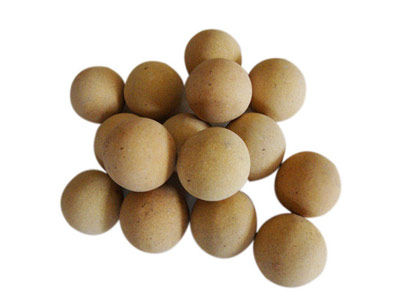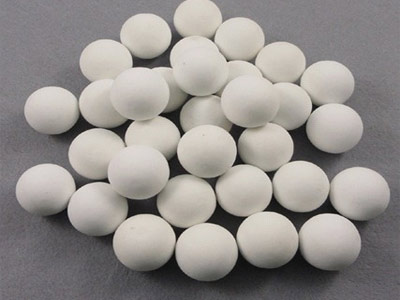Refractory ceramic balls and refractory balls are made of industrial alumina and refractory kaolin as the main raw materials, through scientific formula, shaping, and high-temperature calcination. it has:
- High mechanical strength and long service life.
- It has good chemical stability and does not react chemically with materials.
- Good high-temperature resistance, the heat resistance temperature of refractory porcelain balls can reach 1900 degrees Celsius.
It is especially suitable for high and low-temperature conversion furnaces, reforming furnaces, hydroconverters, desulfurization tanks, and methanation furnaces in fertilizer plants. It plays the role of dispersing gas and liquid, and supporting, covering and protecting the catalyst. Refractory ceramic balls can also be used in hot blast furnaces and heating conversion equipment in the steel industry.
Classification of refractory balls: Refractory porcelain balls are divided into ordinary refractory balls and high-aluminum refractory balls. Ordinary refractory balls are suitable for converters and conversion furnaces in the sulfuric acid and fertilizer industries. High-aluminum refractory balls are suitable for hot blast furnaces, heating conversion furnaces, and other equipment in urea, steel and other industries.

Refractory Ceramic Heat Storage Balls
Heat storage ball is an excellent refractory material. It has significant characteristics such as low shrinkage of the refired line, high softening temperature under high temperature load, corrosion resistance, high strength, large heat storage and release, good thermal shock stability, good thermal conductivity, and small thermal expansion coefficient. By double preheating gas (blast furnace, converter) and air (combustion air single heat storage method is used for oil, high calorific value gas, etc.), the regenerative heating furnace can reduce the smoke exhaust volume by 20-50%. The exhaust gas temperature drops to less than 150 degrees, and the output increases by 15-20%. The billet heating time is shortened by 50%, and the oxidation and burning loss is reduced by 30-50%, which is an environmentally friendly and energy-saving effect.
- 1) The specific surface area of heat storage balls can reach 240m2/m3.
- 2) Numerous small balls divide the air flow into small streams. When the air flows through the heat storage body, it forms strong turbulence, which effectively breaks through the boundary layer on the surface of the heat storage body. And because of the small ball diameter, small conduction radius, small thermal resistance, high density, and good thermal conductivity, it can meet the frequent and rapid reversal requirements of regenerative burners.
- 3) The regenerator can use 20 to 30 reversals per hour. After the high-temperature flue gas flows through the regenerator bed, the flue gas can be reduced to about 130°C and then emitted.
- 4) When high-temperature gas and air flow through the regenerator in the same path, they can be preheated to only about 100°C lower than the flue gas temperature. The temperature efficiency is as high as over 90%.
- 5) Because the heat storage body is very small in size and the small pebble bed has strong circulation capacity, even if the resistance increases after dust accumulation, the heat exchange index will not be affected.
- 6) Thermal storage balls have the characteristics of strong resistance to oxidation and slag.
- 7) The ceramic ball is very convenient to replace and clean, and can be reused.

What are the Functions of Refractory Balls
Refractory ball is a kind of sphere made of industrial alumina and refractory kaolin as the main raw materials, and calcined at high temperature through scientific formula. It is mainly divided into high-aluminum refractory balls, silica refractory balls, magnesium-aluminum refractory balls, porcelain balls, etc. Converters and shift furnaces for the sulfuric acid and fertilizer industries. High-aluminum refractory balls are suitable for hot blast furnaces, heating conversion furnaces and other equipment in urea, steel and other industries.
The main role of refractory balls in actual use is due to their good high-temperature resistance and high hardness. Putting the refractory balls evenly into the heating furnace can evenly distribute the gas. Evenly dispersed gas can reduce the effect on the catalyst and extend the service life of the catalyst. At the same time, it has high hardness, so it can play a supporting role in heating objects in the heating furnace.
The working principle of refractory balls is to divide the air flow into small streams by dividing many small balls. The airflow flows through the heat storage body, forming intense turbulence, which effectively breaks through the boundary layer on the surface of the heat storage body. And because the ball diameter is small, the conduction radius is small, the density is high, and the thermal conductivity is good. Therefore, the requirement of frequent and rapid reversal of the regenerative burner can be realized.
High-aluminum refractory balls are often used during use. Although high-aluminum refractory balls are very hard, they become very brittle after high temperatures. Dry grinding can easily cause cracks in the ball stones and pits on the surface of the ball stones, resulting in very high wear. Therefore, we must pick out the spheres with high cracking and wear during actual use.

